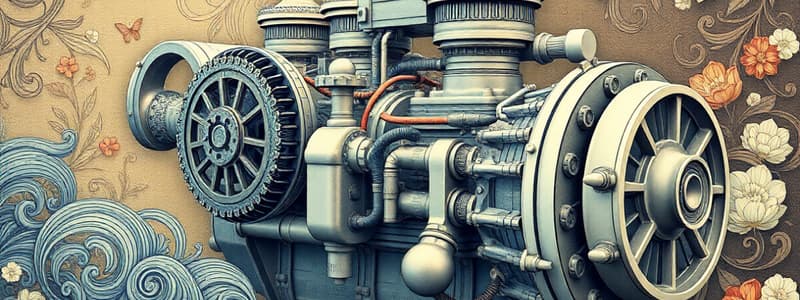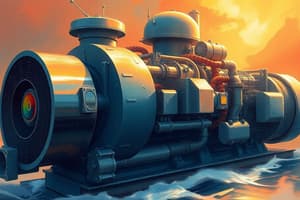Podcast
Questions and Answers
What is the primary reason for using advanced materials in marine diesel engine design?
What is the primary reason for using advanced materials in marine diesel engine design?
- To enhance the aesthetic appeal of engine components.
- To withstand the corrosive marine environment and high operating temperatures. (correct)
- To facilitate easier manufacturing processes.
- To reduce overall weight of the engine components.
Which feature is critical for minimizing noise pollution in marine diesel engines?
Which feature is critical for minimizing noise pollution in marine diesel engines?
- High-performance propellers.
- Routine maintenance practices.
- Specialized insulation and installation techniques. (correct)
- Larger gearboxes to manage torque.
What is an essential aspect of marine engine control systems?
What is an essential aspect of marine engine control systems?
- They do not impact operational efficiency.
- They are purely manual without automation.
- They help manage speed and power output. (correct)
- They are only required during emergencies.
Why is regular routine maintenance crucial for marine diesel engines?
Why is regular routine maintenance crucial for marine diesel engines?
What role do gearboxes play in marine propulsion systems?
What role do gearboxes play in marine propulsion systems?
Which of the following is NOT a primary consideration for seawater protection in marine engines?
Which of the following is NOT a primary consideration for seawater protection in marine engines?
What is a significant trend observed in the future of marine diesel engines?
What is a significant trend observed in the future of marine diesel engines?
What is one of the key benefits of hybrid propulsion systems in marine engines?
What is one of the key benefits of hybrid propulsion systems in marine engines?
Which type of marine diesel engine typically has lower fuel efficiency?
Which type of marine diesel engine typically has lower fuel efficiency?
What is the primary purpose of the fuel injection system in a marine diesel engine?
What is the primary purpose of the fuel injection system in a marine diesel engine?
Which component is responsible for converting the reciprocating motion of the pistons into rotational motion?
Which component is responsible for converting the reciprocating motion of the pistons into rotational motion?
What type of engine design feature aids in managing engine longevity and performance in marine environments?
What type of engine design feature aids in managing engine longevity and performance in marine environments?
What aspect differentiates four-stroke engines from two-stroke engines?
What aspect differentiates four-stroke engines from two-stroke engines?
Which component controls the flow of air and exhaust gases in a marine diesel engine?
Which component controls the flow of air and exhaust gases in a marine diesel engine?
What is the function of exhaust gas recirculation systems in marine diesel engines?
What is the function of exhaust gas recirculation systems in marine diesel engines?
What is the role of the connecting rods in a marine diesel engine?
What is the role of the connecting rods in a marine diesel engine?
Flashcards
Marine Diesel Engines
Marine Diesel Engines
Diesel engines designed for use in ships, prioritizing reliability, durability, and efficiency.
Two-stroke Engine
Two-stroke Engine
Simple design, high power output, but lower fuel efficiency compared to four-stroke engines. Common type: Two-stroke marine diesel.
Four-stroke Engine
Four-stroke Engine
More complex design with better fuel efficiency than two-stroke engines. Common type: Four-stroke marine diesel.
Diesel Cycle
Diesel Cycle
Signup and view all the flashcards
Fuel Injection Systems
Fuel Injection Systems
Signup and view all the flashcards
Exhaust Systems
Exhaust Systems
Signup and view all the flashcards
Lubrication and Cooling
Lubrication and Cooling
Signup and view all the flashcards
Cylinders
Cylinders
Signup and view all the flashcards
Materials
Materials
Signup and view all the flashcards
Durability
Durability
Signup and view all the flashcards
Routine Maintenance
Routine Maintenance
Signup and view all the flashcards
Engine Control Systems
Engine Control Systems
Signup and view all the flashcards
Engine Performance Monitoring
Engine Performance Monitoring
Signup and view all the flashcards
Propellers
Propellers
Signup and view all the flashcards
Gearboxes
Gearboxes
Signup and view all the flashcards
Noise Reduction
Noise Reduction
Signup and view all the flashcards
Study Notes
Introduction to Marine Diesel Engineering
- Marine diesel engines power ships, from small fishing boats to large container vessels.
- These engines are designed for marine environments, prioritizing reliability, durability, and efficiency.
Types of Marine Diesel Engines
- Two-stroke engines: Simple design, high power output, but lower fuel efficiency than four-strokes.
- Four-stroke engines: More complex design, but generally better fuel efficiency than two-strokes; widely used in modern marine applications.
- Rotating machinery: Propellers, gearboxes, and shafts transfer engine power to water. Essential for propulsion.
- Special design features: Specialized lubrication and cooling systems are crucial for marine operation.
Engine Cycles and Operation
- Diesel cycle: Air compression, fuel injection, ignition produce power. Fundamentally how marine diesel engines operate.
- Fuel injection: Precise fuel-air mixture control for complete combustion, optimized power, and efficiency.
- Exhaust system: Safely and efficiently manages exhaust gases, sometimes with exhaust gas recirculation for emission control.
- Lubrication: Essential for engine longevity and performance due to the demanding marine environment.
Components of a Typical Marine Diesel Engine
- Cylinders: Combustion chambers are a critical part of engine design.
- Pistons: Reciprocate; converting combustion energy to mechanical work.
- Crankshaft: Rotational motion from pistons' reciprocating motion.
- Connecting rods: Link pistons to the crankshaft.
- Valves: Control the flow of air and exhaust gases.
- Fuel pumps and injectors: Deliver fuel for combustion.
- Cooling systems: Critical for high-temperature operation.
Marine Diesel Engine Design Considerations
- Materials: Durable materials are chosen to withstand the marine environment's corrosive properties and high operating temperatures.
- Durability: Engine design accounts for extreme vibrations and stresses inherent in marine use.
- Maintenance: Specialized maintenance is needed to ensure long life and optimal performance.
- Seawater protection: Coatings and enclosures safeguard components from saltwater damage.
- Noise reduction: Minimizing noise is important for ship operations.
- Emissions control: Strict regulations require specific equipment or strategies to control exhaust emissions.
Governing and Monitoring
- Engine control systems: Regulate speed, power output and other parameters.
- Engine performance monitoring: Sensors and systems assess engine health and efficiency.
Propulsion Systems
- Propellers: Convert engine power to thrust; affect speed and efficiency.
- Gearboxes: Adjust speed and torque output to match propeller needs.
Operation and Maintenance
- Routine maintenance: Regular checks, lubrication, and inspections prevent failures and extend engine life.
- Emergency procedures: Systems and protocols address failures/malfunctions for safe operation.
- Troubleshooting and repairs: Effective problem identification and resolution are paramount for continuous operation.
- Safety requirements: Robust safety systems are crucial for personnel and vessel safety in marine environments.
Advanced Technologies
- Alternative fuels: Ongoing research into alternative fuels and engine technologies is aimed at reducing emissions and improving fuel efficiency.
- Hybrid propulsion systems: Diesel engines combined with electric motors/batteries improve fuel efficiency and reduce emissions.
- Digitalization and automation: Digital monitoring and automated control systems enhance efficiency and safety.
Future Trends
- Increased automation: More automated systems and remote monitoring for increased efficiency are emerging trends.
- Sustainable approaches: Reducing emissions and using cleaner fuels are key drivers of technological innovation.
Studying That Suits You
Use AI to generate personalized quizzes and flashcards to suit your learning preferences.




